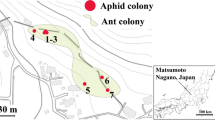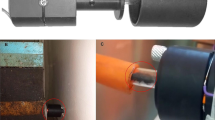Abstract
In social insects the level of defensive effort generally increases with colony size, but the effects of the size of the defending adult population and the size of the brood population being defended have not been separated. We used pre-emergence-stage colonies of the swarm-founding wasp, Polybia occidentalis, to distinguish the effects of these two parameters on the intensity of colony defense. We elicited defensive behavior by using both mechanical (taps) and chemical (alarm-pheromone-containing venom) stimuli, and scored the responses as the number of attacks on a standard target. The intensity of defense increased linearly throughout the colony's first 25 days of development, despite the decrease in absolute numbers of adults during the same period. That is, the per capita attack rate increased strongly during this period, leading us to conclude that the intensity of defense is a function of the colony's investment in brood and not of the number of defending adults. We provide evidence that the increase is attributable neither to sensitization due to frequent disturbance, nor to the aging of the adult wasps. We further show that defensive effort on a per capita basis decreased with increasing size across colonies, whether colony size was measured as number of adults or as investment in brood. This pattern suggests that the cost-benefit relationship of defending the colony changes with colony size.



Similar content being viewed by others
References
Akre RD, Reed, HC (1984) Vespine defense. In: Hermann HR (ed) Defensive mechanisms in social insects. Praeger, New York, pp 59–94
Bouwma PE, Bouwma AM, Jeanne RL (2000) Social wasp swarm emigration: males stay behind. Ethol Ecol Evol 12:35–42
Bouwma AM, Bouwma PE, Nordheim EV, Jeanne RL (2003) Adult mortality rates in young colonies of a swarm-founding social wasp. J Zool 260:11–16
Dani FR, Jeanne RL, Clarke SR, Jones GR, Morgan ED, Francke W, Turillazzi S (2000) Chemical characterization of the alarm pheromone in the venom of Polybia occidentalis and of volatiles from the venom of Polybia sericea (Hymenoptera: Vespidae: Epiponini). Physiol Entomol 25:363–369
Forsyth AB (1978) Studies on the behavioral ecology of polygynous social wasps. PhD dissertation. Harvard University, Cambridge, Mass.
Forsyth AB (1981) Swarming activity of polybiine social wasps (Hymenoptera: Vespidae: Polybiini). Biotropica 13:93–99
Gadagkar, R (2001) The social biology of Ropalidia marginata. Harvard University Press, Cambridge, Mass.
Hepburn HR, Radloff SE (1998) Honeybees of Africa. Springer, Berlin Heidelberg New York
Hermann HR (ed) (1984) Defensive mechanisms in social insects. Praeger, New York
Hölldobler B, Wilson EO (1990) The ants. Harvard University Press, Cambridge, Mass.
Huang ZY, Robinson GE (1992) Honeybee colony integration: Worker-worker interactions mediate hormonally regulated plasticity in division of labor. Proc Natl Acad Sci 89:11726–11729
Jeanne RL (1981) Alarm recruitment, attack behavior, and the role of the alarm pheromone in Polybia occidentalis (Hymenoptera: Vespidae). Behav Ecol Sociobiol 9:143–148
Jeanne RL (1986) The organization of work in Polybia occidentalis: costs and benefits of specialization in a social wasp. Behav Ecol Sociobiol 19:333–341
Jeanne RL (1991) The swarm-founding Polistinae. In: Ross KG, Matthews RW (eds) The social biology of wasps. Cornell University Press, Ithaca, N.Y., pp 191–231
Jeanne RL (1999) Group size, productivity, and information flow in social wasps. In: Detrain C, Pasteels JM, Deneubourg JL (eds) Information processing in social insects. Birkhäuser, Basel
Jeanne RL, Nordheim EV (1996) Productivity in a social wasp: per capita output increases with swarm size. Behav Ecol 7:43–48
Jeanne RL, Williams NM, Yandell BS (1992) Age polyethism and defense in a tropical social wasp (Hymenoptera: Vespidae). J Insect Behav 5:211–227
Judd TM (1998) Defensive behavior of colonies of the paper wasp, Polistes fuscatus, against vertebrate predators over the colony cycle. Insectes Soc 45:1–12
Knight RL, Temple SA (1986) Why does intensity of avian nest defence increase during the nesting cycle? Auk 103:318–327
Landolt PJ, Jeanne RL, Reed HC (1998) Chemical communication in social wasps. In: Vander Meer RK, Breed M, Winston ML, Espelie K (eds) Pheromone communication in social insects. Westview, Boulder, Colo., pp 216–235
Machado VLL (1977) Estudos biológicos de Polybia occidentalis (Olivier, 1791) (Hym. -Vespidae). Ann Soc Entomol Brasil 6:7–24
Minitab (1998) Statistical software release 12. Minitab Inc., State College, Pa.
Oster GF, Wilson EO (1978) Caste and ecology in the social insects. Princeton University Press, Princeton, N.J.
Richards OW (1978) The social wasps of the Americas, excluding the Vespinae. British Museum Natural History, London
Robinson GE (1992) Regulation of division of labor in insect societies. Annu Rev Entomol 37:637–665
Roubik DW (1989) Ecology and natural history of tropical bees. Cambridge University Press, Cambridge, UK
SAS (1999) SAS Institute Inc. Cary, N.C.
Schneider SS, McNally LC (1992) Colony defense in the African honey bee in Africa (Hymenoptera: Apidae). Environ Entomol 21:1362–1370
Schwarz HF (1931) The nest habits of the diplopterous wasp Polybia occidentalis variety scutellaris (White) as observed at Barro Colorado, Canal Zone. Am Mus Novit 471:1–27
Seal JN (2002) Investment does not predict nest defense by the tropical social paper wasp Polistes instabilis de Saussure (Hymenoptera: Vespidae). J Kans Entomol Soc 75:335–338
Spradbery JP (1973) Wasps: an account of the biology and natural history of solitary and social wasps. University of Washington Press, Seattle
Trivers RL (1972) Parental investment and sexual selection. In: Campbell B (ed) Sexual selection and the descent of man 1871–1971. Aldine, Chicago, pp 136–179
Tschinkel WR (1992) Sociometry and sociogenesis of colonies of the fire ant Solenopsis invicta during one annual cycle. Ecol Monogr 63:425–457
Vander Meer RK, Breed M, Winston ML, Espelie K (eds) (1998) Pheromone communication in social insects. Westview, Boulder, Colo.
Wernstedt FL (1972) World climatic data. Climatic Data, Lemont, Pa.
West-Eberhard MJ (1982) The nature and evolution of swarming in tropical social wasps (Vespidae, Polistinae, Polybiini). In: Jaisson P (ed) Social insects in the tropics, vol 1. Université de Paris-Nord, pp 97–128
Acknowledgements
We thank the Hagnauer family for permission to work on their property and for logistical support. We express our thanks also to Paul Hanson for logistical support in Costa Rica. Jeffrey Baylis, Jack Hailman, David Hogg, and Daniel Young advised the planning stages and gave feedback later. We are grateful to Erik Nordheim and Kevin Gross for statistical advice, and to Andy Bouwma, Ken Howard, Jenny Jandt, and two anonymous reviewers for suggestions that improved the manuscript. The work reported herein complies with the laws of Costa Rica. Research supported in part by a National Science Foundation predoctoral fellowship and international travel allowance, the Davis Fund of the Department of Zoology, the Kinney Fund of the Department of Entomology (all to K.B.L.), NSF grant IBN-9514010 (to R.L.J.), and by the College of Agricultural and Life Sciences, University of Wisconsin-Madison.
Author information
Authors and Affiliations
Corresponding author
Additional information
Communicated by R.F.A. Moritz
Rights and permissions
About this article
Cite this article
London, K.B., Jeanne, R.L. Effects of colony size and stage of development on defense response by the swarm-founding wasp Polybia occidentalis . Behav Ecol Sociobiol 54, 539–546 (2003). https://doi.org/10.1007/s00265-003-0662-8
Received:
Revised:
Accepted:
Published:
Issue Date:
DOI: https://doi.org/10.1007/s00265-003-0662-8




